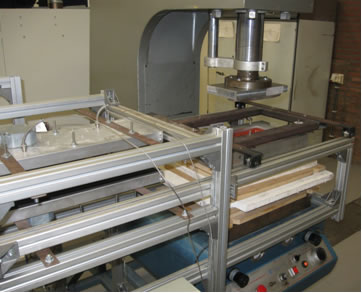Lightweight Structures BV, Netherlands
Manufacture of sole plates with Biopreg
Introduction
The Heelless shoe requires a stiff sole plate in order to keep the sole in the right shape. Objective within the Heelless project is to manufacture the sole plate by thermoforming a natrural fibre composite laminate. These laminates are made from the Biopreg material made by Zwarz and de Weerd. The implementation of the thermoforming process and the required tooling are to be determined by LS.
Tooling
The first sole plates for the Heelless shoe were manufactured by using a technology called compression forming. This is a thermoforming technique consisting of three steps: 1) the material is heated, 2) the material is formed and 3) it is compressed and cooled down between two moulds. The setup of this technique that has been built is shown below;

Setup for compression forming technique
First, the material is clamped in a frame and it is heated between two IR panels (left on the picture). After a certain heating time the matrix material of the composite has reached a temperature where it is sufficiently softened. Then the frame with the material is transferred to the right between upper and lower mould and the press will be closed. This is a fast pneumatic press (20 tons max). In this case the upper mould is made from aluminium while the lower mould is made from rubber that is contained by an aluminium casing.
Making one of moulds out of rubber has a few advantages:
- It's form adjusts itself to the aluminium mould. This means that it allows different material thicknesses.
- A rubber mould under pressure will act hydrostatically. It means that vertical walls in some products will also be compressed (reconsolidated) although the direction of the acting force is only vertical.
A disadvantage of rubber moulds can be the wear that it will suffer from. This mould was made from silicon rubber, which allows high temperatures.
Sole plate samples
The sole plates are manufactured from Biopreg. This is a prepreg made from natural fibres and a thermoplastic matrix.
The forming of a composite laminate with continuous fibres is different from standard deep drawing of metals or plastics. Here, the composite material is not able to stretch by plastic deformation. Forming can only occur through bending and through shearing of the reinforcing fabric. In other words the material can only be draped into its final shape. This means that the shaping is determined by the draping capabilities of the material, if the form is too deep, draping is not possible and wrinkles (foulds) will occur. Draping can be improved with the lay-out of the clamping frame. By clamping the material on certain points, the shearing can be steered. In case of the sole plate the clamping frame was attached to the material with four points. See picture below;

Biopreg material clamped on the four corners before compression forming
This is the position after heating, just before the material is pressed between both moulds.
The first range of Biopreg material samples that have been compression formed into sole plates served three purposes;
- To get familiar with the compression forming process. How can the material be handled, which process parameters are appropriate,
- To investigate different types of Biopreg material, what was their behaviour during the forming process, and
- To get the first sets of sole plates, required for the manufacture of the first Heelless shoe prototypes. These shoes will be tested, in order to get first impressions of the effect of the sole plate in the shoe.
With the Biopreg material that is used now it was possible to manufacture the first sole plates that can be used for first investigations on shoe prototypes. A further fine tuning of the Biopreg formulation is still possible.
Lightweight Structures BV, Netherlands
Research regarding Lightweight Structures BV, from the Netherlands
